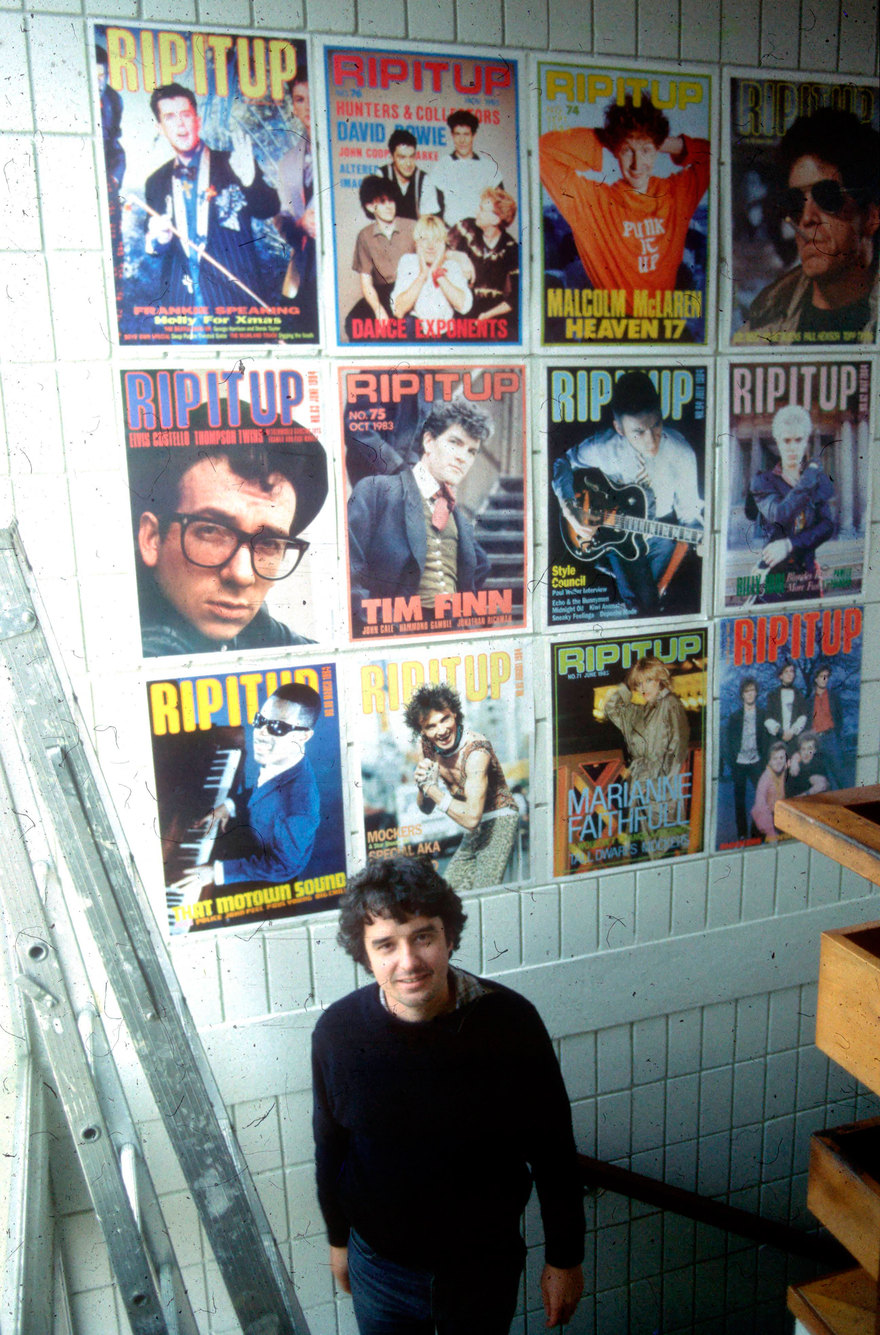
Murray Cammick in the stairwell of the Crummer Road offices in 1987. Photo by Darryl Ward.
The vitality of the contemporary New Zealand music scene is unthinkable without the commitment of Murray Cammick as the co-founder, editor and publisher of Rip It Up for 21 years, and his creation of the Southside and Wildside labels.
Murray's talents as an editor, photographer and writer are also central to the design and tone of AudioCulture.
The announcement that Murray has been named as an Officer in the New Zealand Order of Merit in the 2020 New Year's Honours is a much-deserved recognition of his contribution to New Zealand popular culture. Here he writes about his most prominent creation.
--
In June 1977 the first issue of the free music magazine Rip It Up appeared in music stores nationwide. The magazine was a modest 16 pages of tabloid newsprint folded in half with the Commodores on the cover.
The publishers were myself, as designer, hustler and photographer, and Alastair Dougal as the editor. Alastair knew where to put the commas and the full stops, and as a musician, he had a great instinct for appreciating recorded and live music, both foreign and local. We were friends from our school days at Glendowie College and we’d both got degrees at Auckland University. I had been the designer on Auckland University Students Association magazine Craccum in 1976 and for some unknown reason, we decided to pool our resources ($500 each, plus hard labour) and fill the gap in the market left by the closure of the music magazine Hot Licks in 1976.
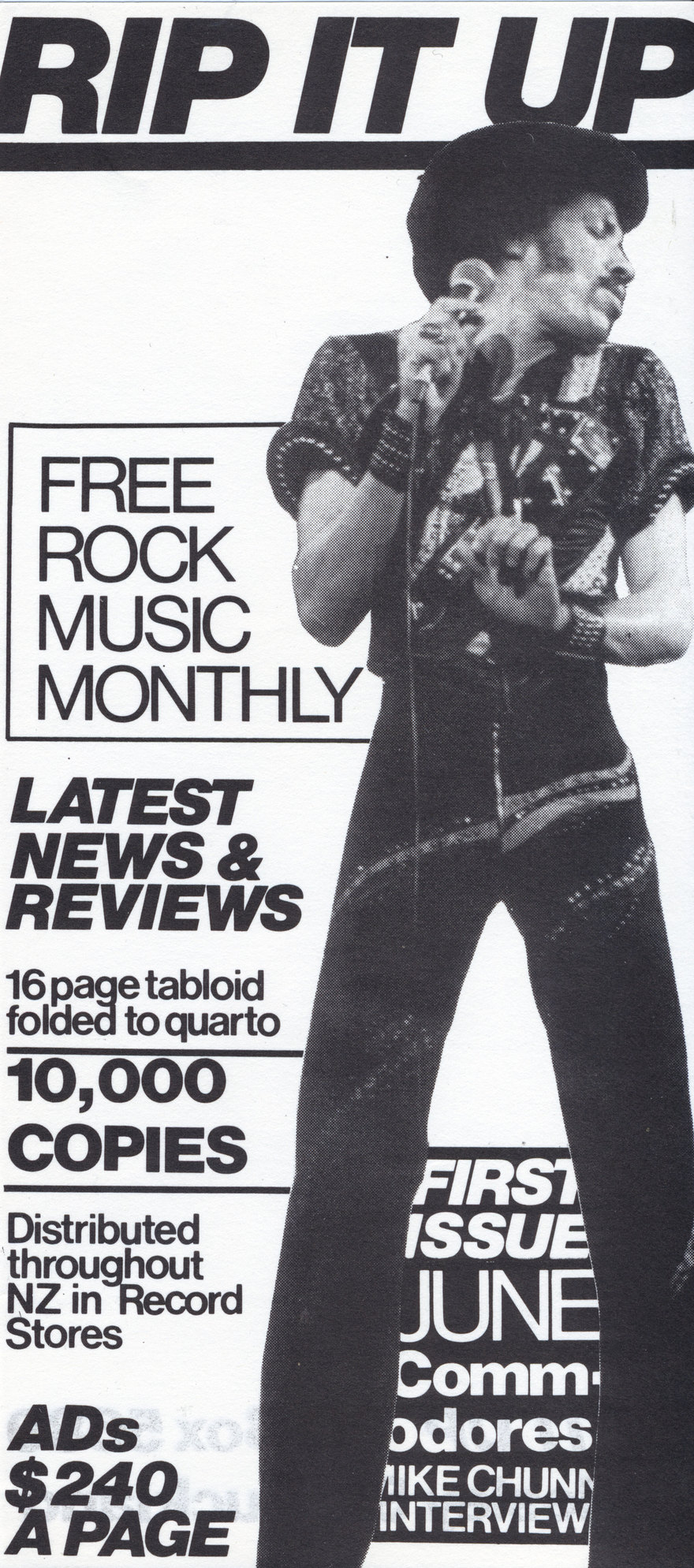
Rip It Up is coming: an advertising rate card for the first issue
The new Rip It Up magazine was not as sophisticated as its predecessor Hot Licks — a monthly music magazine that had been free from February 1974 to July 1975, and then followed that with 11 issues sold on the newsstands at 40 cents, before it folded when its owner, Direction Records, went bust.
Ironically, the intended centrespread of the final Hot Licks (it was never printed), was my photo story of V8 cars in Auckland’s Queen Street. The new editor of that final Hot Licks was a friend, Jeremy Templer, who then went south to join the NZ Listener.
Early in 1977 Alastair Dougal and I had gone to lunch with the founding Hot Licks editor, Roger Jarrett, to discuss our idea to publish a music magazine and he informed us that promoter Hugh Lynn had also spoken to him about starting a music magazine. We knew that Jeremy Templer intended to start a magazine after his stint at the NZ Listener, so Alastair and I moved quickly to be first to occupy the gap Hot Licks had vacated.
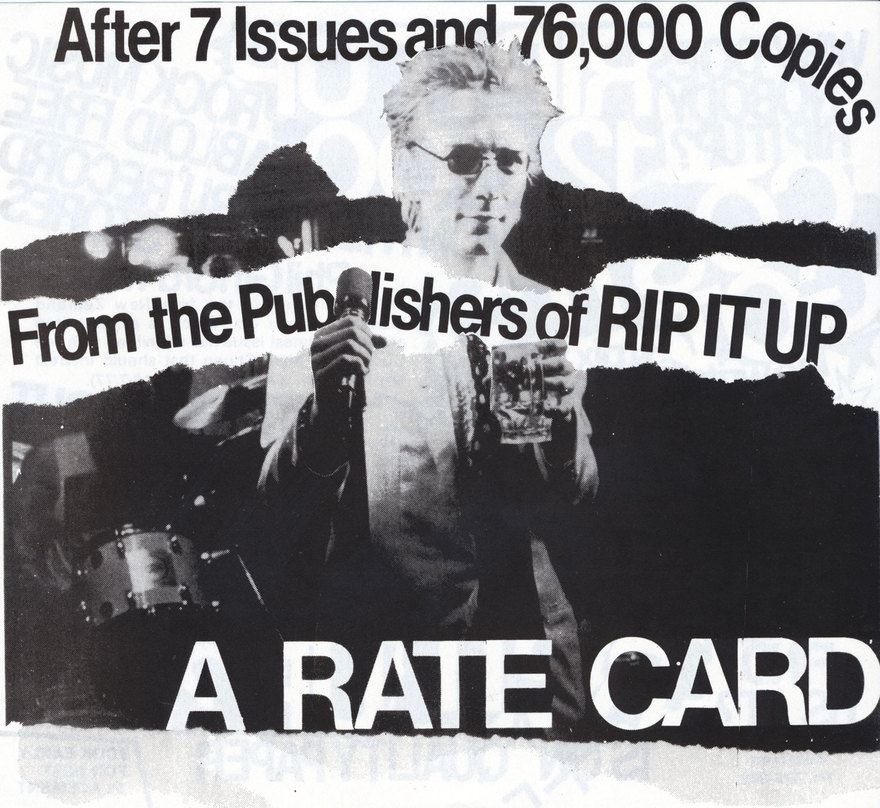
The "punk" rate card from 1978
Why did we start a music magazine? I guess, in those days, the US music magazine Rolling Stone was the coolest of cool and being a "rock writer" or "rock photographer" was something a young guy who sucked at sport could aspire to be.
If I said I was a "rock photographer" today, people would think I was interested into geology but in the mid-1970s "rock" was good music and "pop" was bad music and to be credible you had to have long hair and wear jeans. Things were about to change.
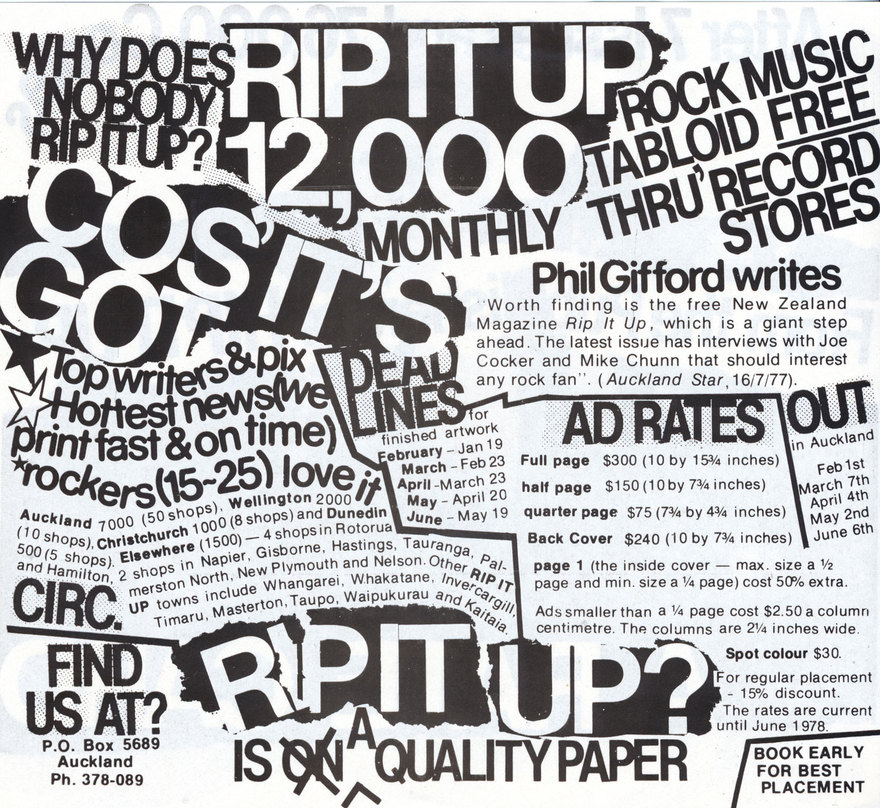
The reverse
As a young soul music fan I did ponder whether Motown acts could be credible whilst wearing suits. I did not have to fret for long as they soon joined the denim revolution. As a reader of Hot Licks I thought there was not enough coverage of soul music or New Zealand music and too much country-rock and progressive-rock. There was a need to get back to the basics of rock and roll.
Alastair Dougal, myself and many music friends, were blown away by the 1973 rock and roll revival movie Let The Good Times Roll, starring Little Richard, Chuck Berry, Bo Diddley, The Shirelles etc. In the mid 1970s Little Richard played Western Springs and he seemed as crazy and as contemporary as he did in the 1950s.
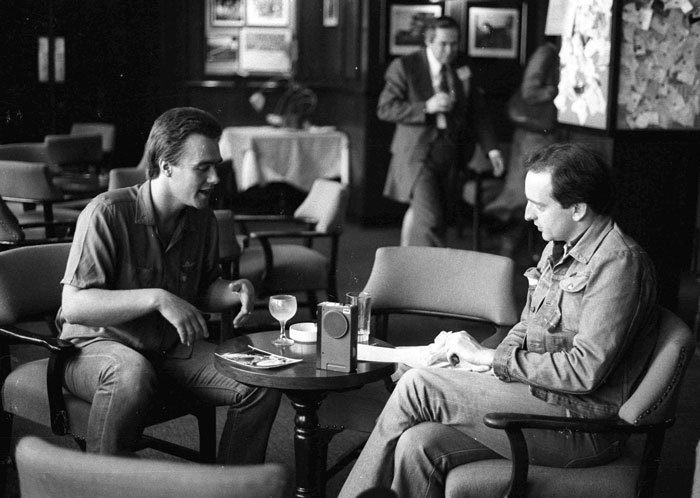
The original Rip It Up editor and co-founder, Alastair Dougal with Brinsley Schwartz (of the band of the same name), seen here when he was in New Zealand with Graham Parker & The Rumour in 1978 - Photo by Murray Cammick
When looking for a title for our new music magazine we looked through the song titles of Chuck Berry and Little Richard. We didn’t consider the Little Richard chorus “Wop Bop A Loo Bop A Lop Bam Boom” as it had just been used as a book title by author Nik Cohn. Maybe it was that book that made us look at song titles. I sat in Snaps Photography Gallery (our first office) in Airedale Street, on the phone to Alastair as he read out, first Chuck Berry and then Little Richard song titles. He said "Rip It Up" and I said or we both said, "You can’t call a magazine that." After a few days of trying to do a logo for an alternative title – "The Little Rock Paper" – the Little Richard song title seemed strangely appealing. I viewed the name as ironic rather than anarchic.
Snaps Photography Gallery in Airedale Street was a great location in 1977. We were just up the road from Charley Gray’s new original music venue, the Island of Real. Radio announcer and photographer Bryan Staff arrived in town in 1977 and visited the gallery. He was soon helping staff Snaps, Rip It Up distribution, and was on Auckland’s 1ZM evening show with a 1978 slogan, “More local talent than most record companies have ever heard.” He went on to do AK79, release many a fine 45 on his Ripper label, and he took over the Island of Real venue, renaming it XS Café.
Our initial print run was 10,000, moving to 12,000 in 1978, and we were soon printing over 20,000 monthly, with a bumper 40,000 copies one crazy month.
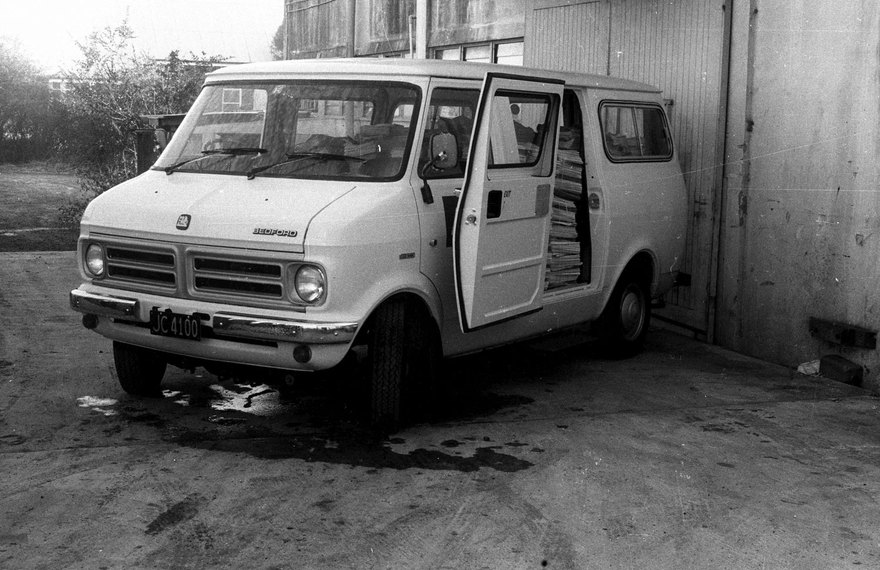
The van picking up magazines in Putaruru, 1980s
A year prior to Rip It Up starting, I do not recall being aware of punk music. But by 1977, the advent of punk in the UK created an international move back to the basics with punk and new wave and a rejection of rock’s pretentious excesses.
To me Rip It Up meant a back to basics philosophy (including Blondie, Talking Heads, Iggy Pop, Bruce Springsteen, Tom Petty and even Thin Lizzy), but some readers probably thought Rip It Up was a punk slogan. To confuse matters I started thinking punk layout involved ripping everything up, literally. For our 1977 advertising rate card we used a photo of the Commodores but for our 1978 rate card we used Johnny Rotten.
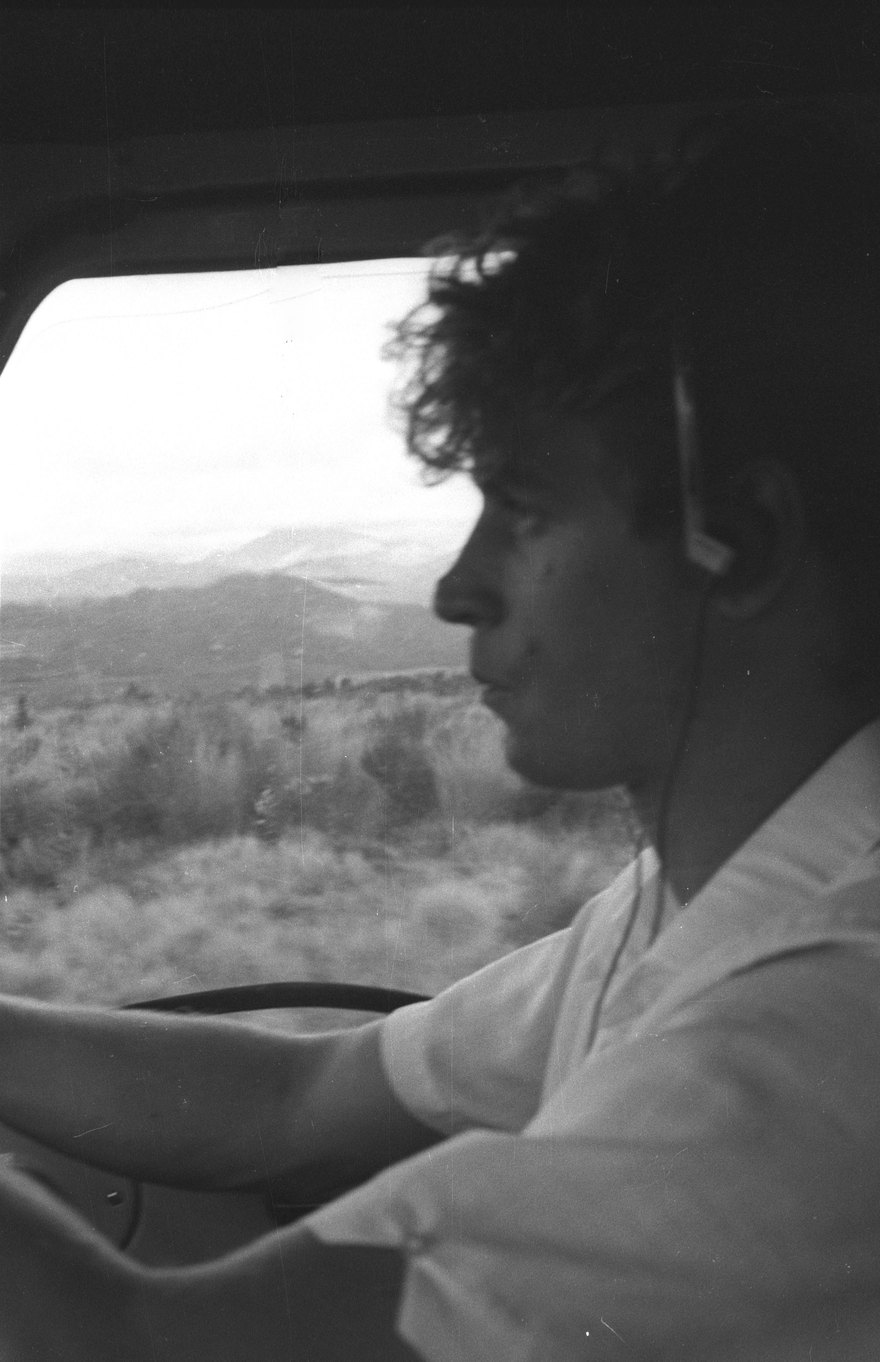
Writer Mark Phillips driving the Rip It Up van in the early 1980s
The start of our magazine in the years that punk shook the music scene up was a fortunate coincidence, as it meant that we were publishing in very interesting times. If cool had been Rolling Stone magazine in the early 1970s, by the close of the decade it was London’s New Musical Express and all eyes were on the United Kingdom for the decade that followed. Rip It Up became a news, reviews, interviews magazine like NME, with too much content crammed into a limited space with small photos.
In 1977 the NME in a magazine store was about two to three months old, so I sent British postal notes to my brother in London, who airmailed us the new NME each week.
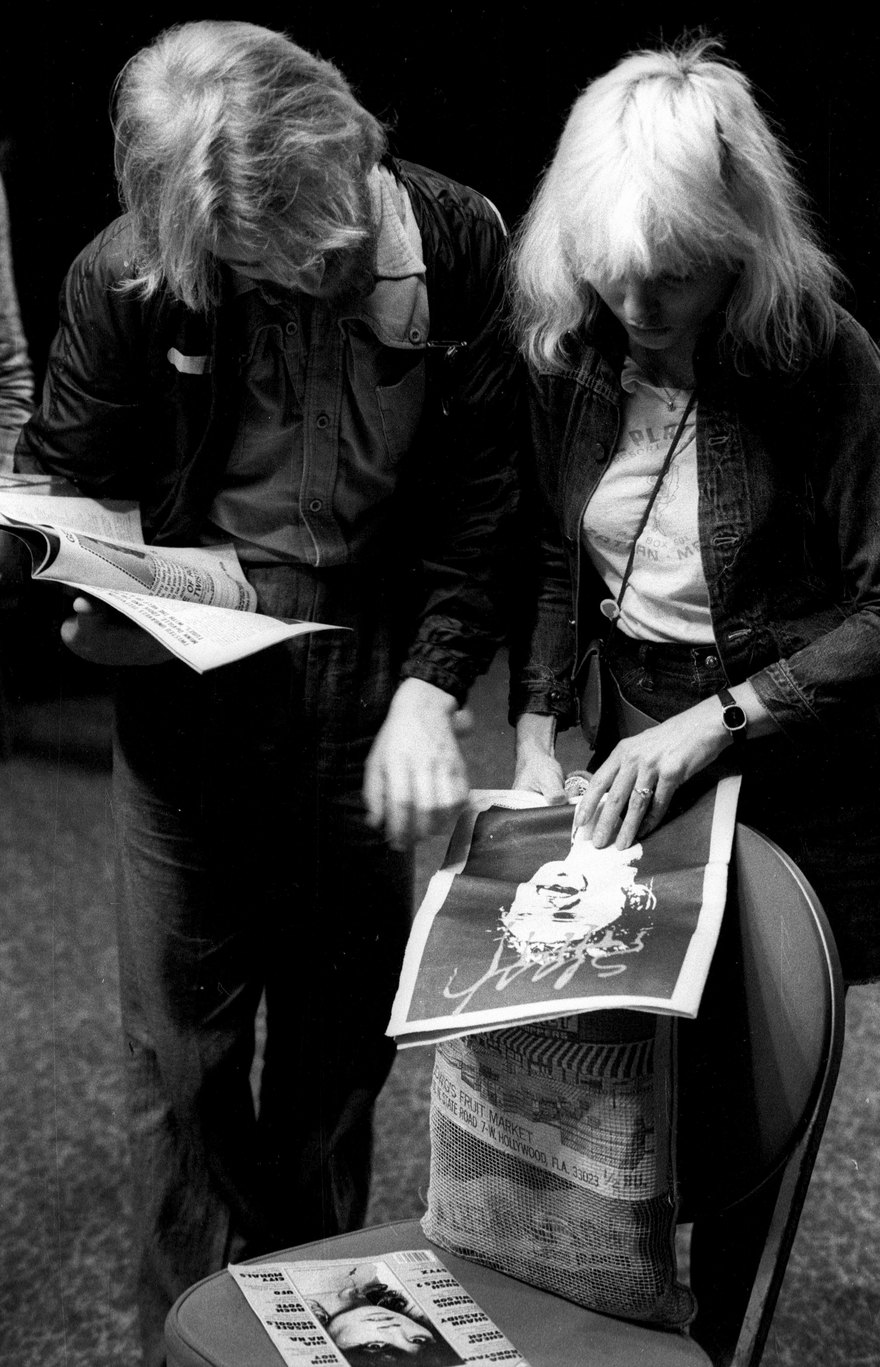
Late 1977 Debbie Harry gives writer Jeremy Templer a copy of LA punk magazine Slash, issue No.3, August 1977
Where did we get our writers? To use a skateboard analogy, if you build a fine ramp, skateboarders will come running to you. In 1977 the music writers came running to Rip It Up, holding pieces of paper. We started with friends who also had just gained degrees at Auckland University – Peter Thomson, Frank Stark, John Malloy, Bruce Belsham, soon added George Kay and Roy Colbert from Dunedin, Ken Williams and Duncan Campbell from the Radio I newsroom, and Jeremy Templer became a key writer even though we had sort of stolen his idea. Alastair Dougal, Frank Stark, myself and the less frequent contributor Louise Chunn had all written for the 1976 Craccum arts or music pages, so the core of Rip It Up came from Craccum.
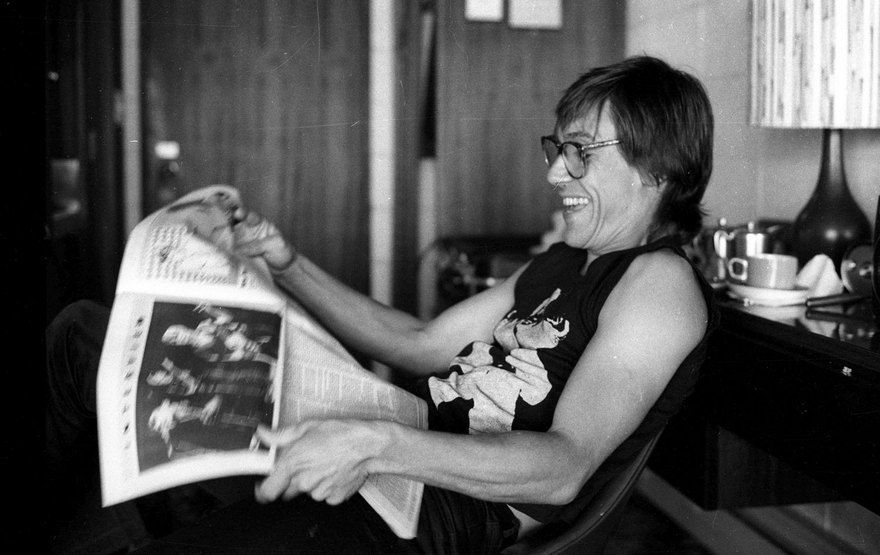
Iggy Pop reads Rip It Up, 1979
For issue one Alastair did pursue one big name writer – a hip university music lecturer with a large record collection, who used to do lunchtime talks on obscure greats of rock music. We thought we needed him, like Rolling Stone had Ralph Gleason, so Alastair asked William Dart to be our big name columnist.
We interviewed Mike Chunn in issue one after he quit Split Enz. He reviewed albums for us and even reviewed our first punk gig – Suburban Reptiles and The Scavengers at Auckland University – when no other writer was keen.
For issue one Eddie Rayner was happy to send us a Split Enz update from London. With New Zealanders doing OEs to London, by 1979 we soon had stories or reviews contributed from London by Kerry Doole, Jeremy Templer, Mairi Gunn and Peter Thomson.
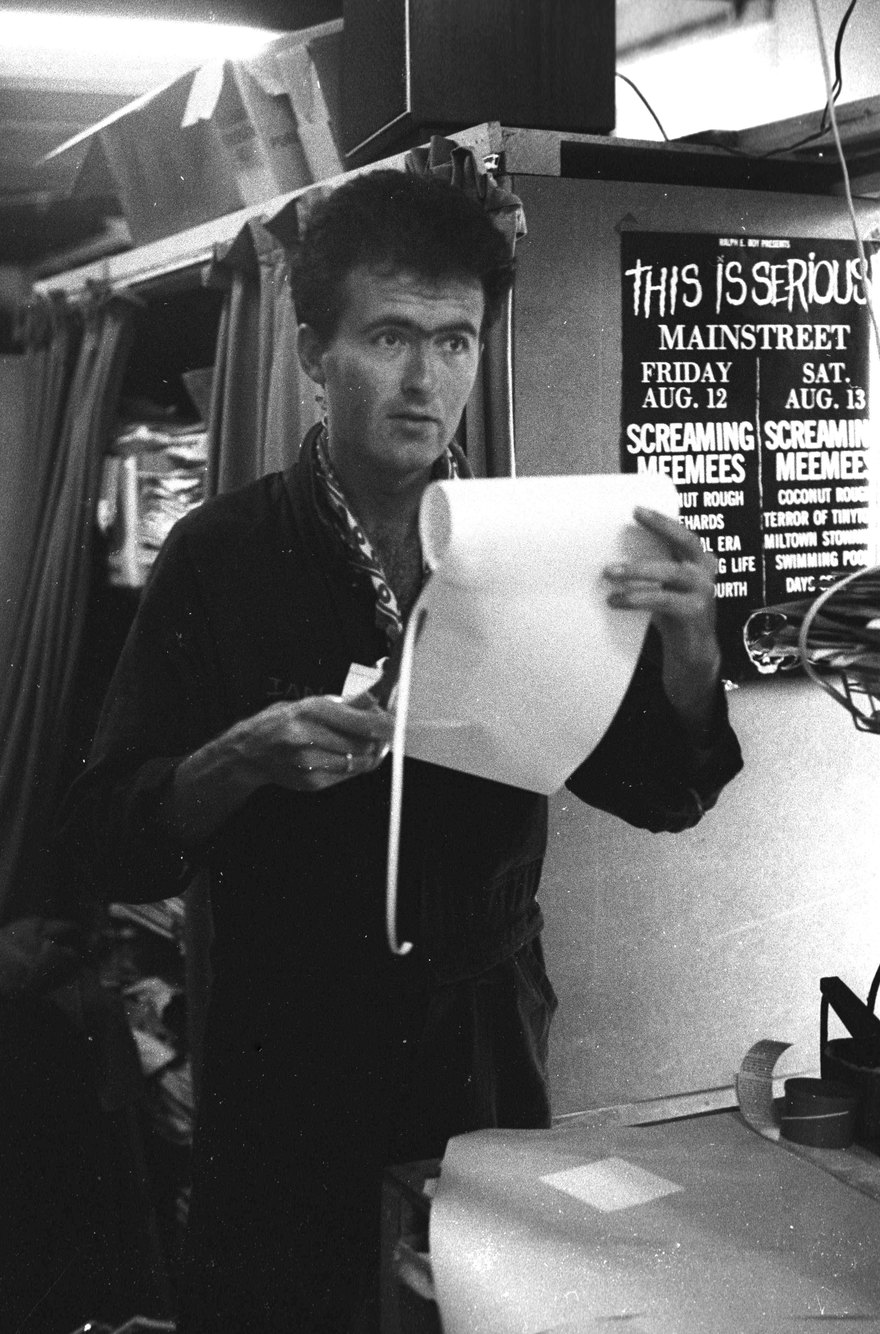
Designer Ian Dalziel at the Darby Street offices in the mid 1980s
The weird thing about pre-computer writing is that every writer had a different typewriter, so you could recognise their writing by their typewriter – sort of like a fingerprint. We also wrote “letters” to each other, so one has archival communication that is “off the record” but not as informal or disposable as an e-mail.
In December 1977 Kerry Doole reviewed the Split Enz UK concert appearance on BBC2 and on the opposite page Roy Colbert heralded the arrival of the Dunedin scene with a review of The Enemy (fronted by Chris Knox) at the Old Beneficiaries Hall. His first sentence was, “Dunedin’s first New Wave Dance.”
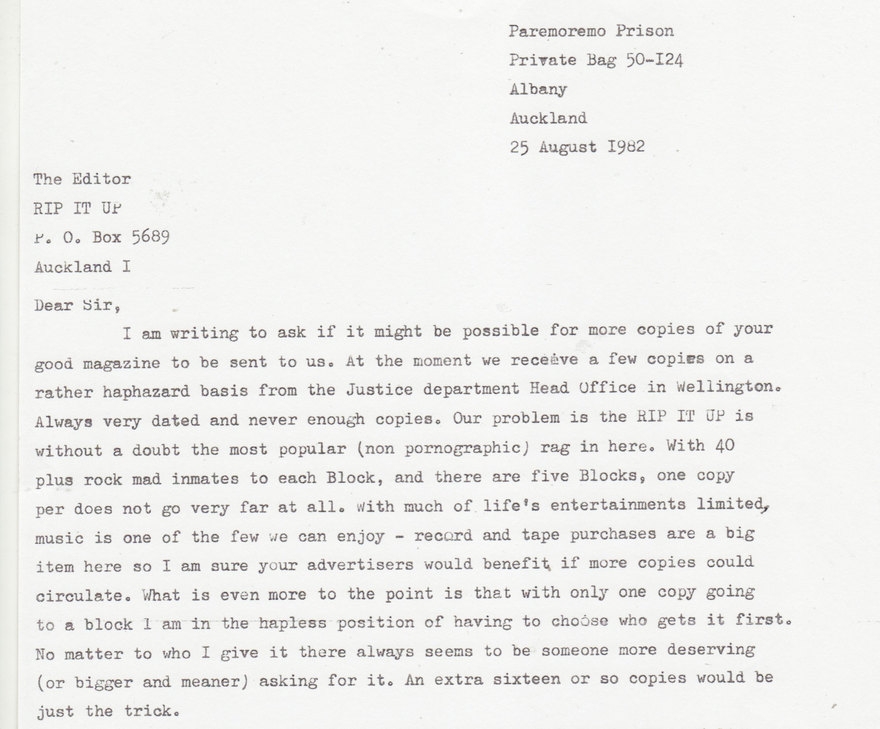
Murray Cammick's "best letter ever to Rip It Up" - from inside
In the 1970s, student newspapers and Hot Licks had to print outside Auckland as the two large Auckland publishers claimed they had no capacity, whereas the small provincial papers had excess printing press capacity. Craccum and Hot Licks were printed at Wanganui Newspapers but Rip It Up found a home at Putaruru Press. In an era in which music journalists had to quote musicians saying “fuck” (or f**k or ****), provincial New Zealand printers were more liberal than big city papers.
Rip It Up was not as slick looking as Hot Licks but soon gained respect for our thorough coverage of the contemporary music scene and a non-condescending attitude to New Zealand music. With our pro-soul and pro-NZ perspective, we put singer Mark Williams on the cover of issue two.
When Alastair wanted to put local band Hello Sailor on the cover of issue three I was not so sure. I remember saying, "Why are we putting a band who plays a tiny university pub, The Globe, on the cover?" His answer was that their songs and performance were of an equal standard to the foreign bands that play bigger venues.
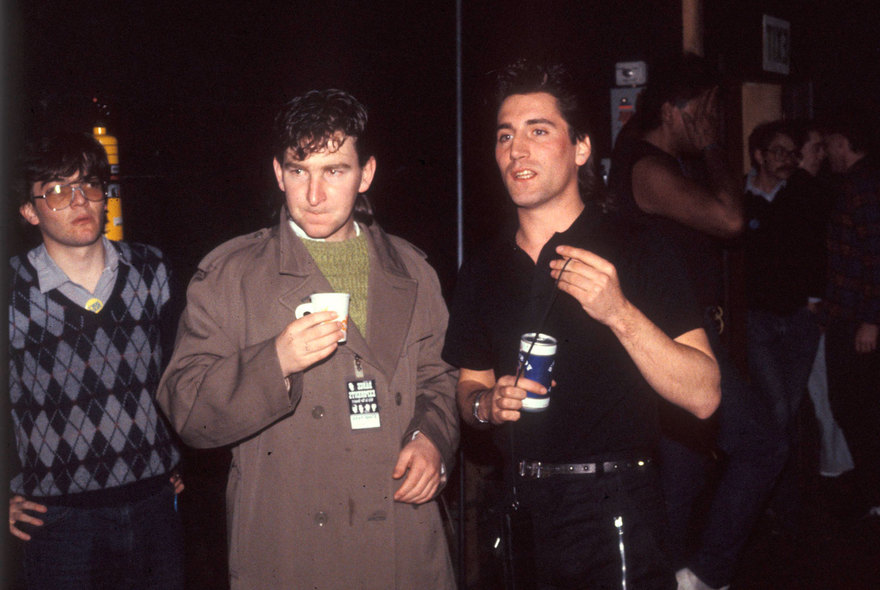
Paul Rose, Russell Brown and Jordan Luck backstage at The Logan Campbell Centre.
The record companies had different reactions to the arrival of Rip It Up. Festival Records, WEA (now Warner Music) and RCA (now part of Sony) were immediately supportive. We gained a friend at WEA when Terence Hogan became the graphic artist in the WEA promotions team. He had written for Hot Licks and also wrote for Rip It Up. He was behind WEA signing Toy Love.
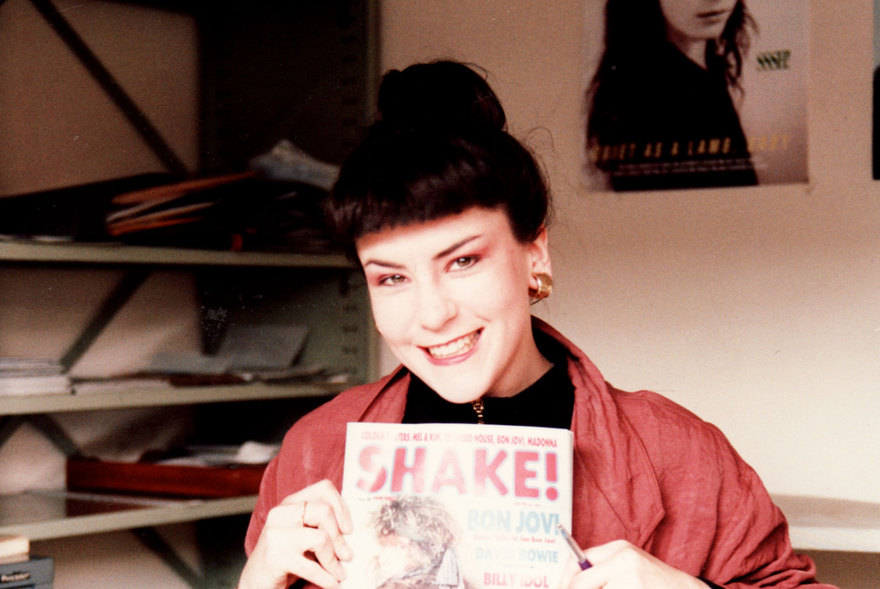
Shake! writer Babs Baker
I recall the promotions manager of Festival, Kevin Williams, saying, "It’s great having Rip It Up. When overseas people asked me the name of our music paper, it was so embarrassing to say we didn’t have one."
The Wellington based labels EMI and PolyGram were not as regular in support of the new venture. I decided to fly to Wellington to drum up some interest – my first plane flight. I had an appointment to see PolyGram marketing manager Stuart Rubin. Once I got to Miramar he said he was too busy to see me. His off-sider Kama Fitzgerald was embarrassed and drove me back to Wellington city.
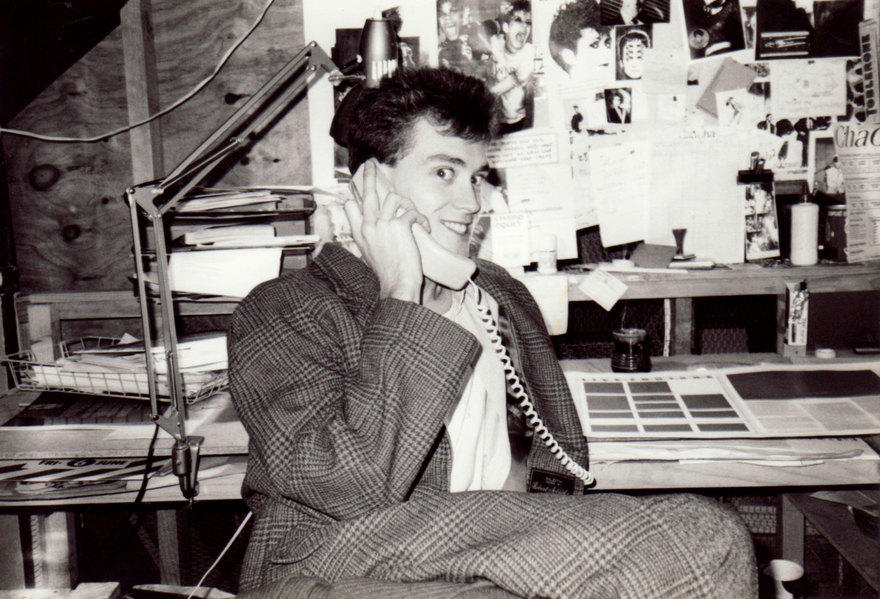
Writer Chad Taylor
A year later a very supportive Kama Fitzgerald was working at fledgling indie Auckland distributor RTC, who had the Virgin label and numerous UK indies including Factory, and the times we were living in became even more interesting.
At the beginning of 1978, CBS Records opened in New Zealand and Managing Director John McCready wanted to book the two best ad spaces in Rip It Up, indefinitely. The tide turned for Rip It Up and all the major labels became regular advertisers.
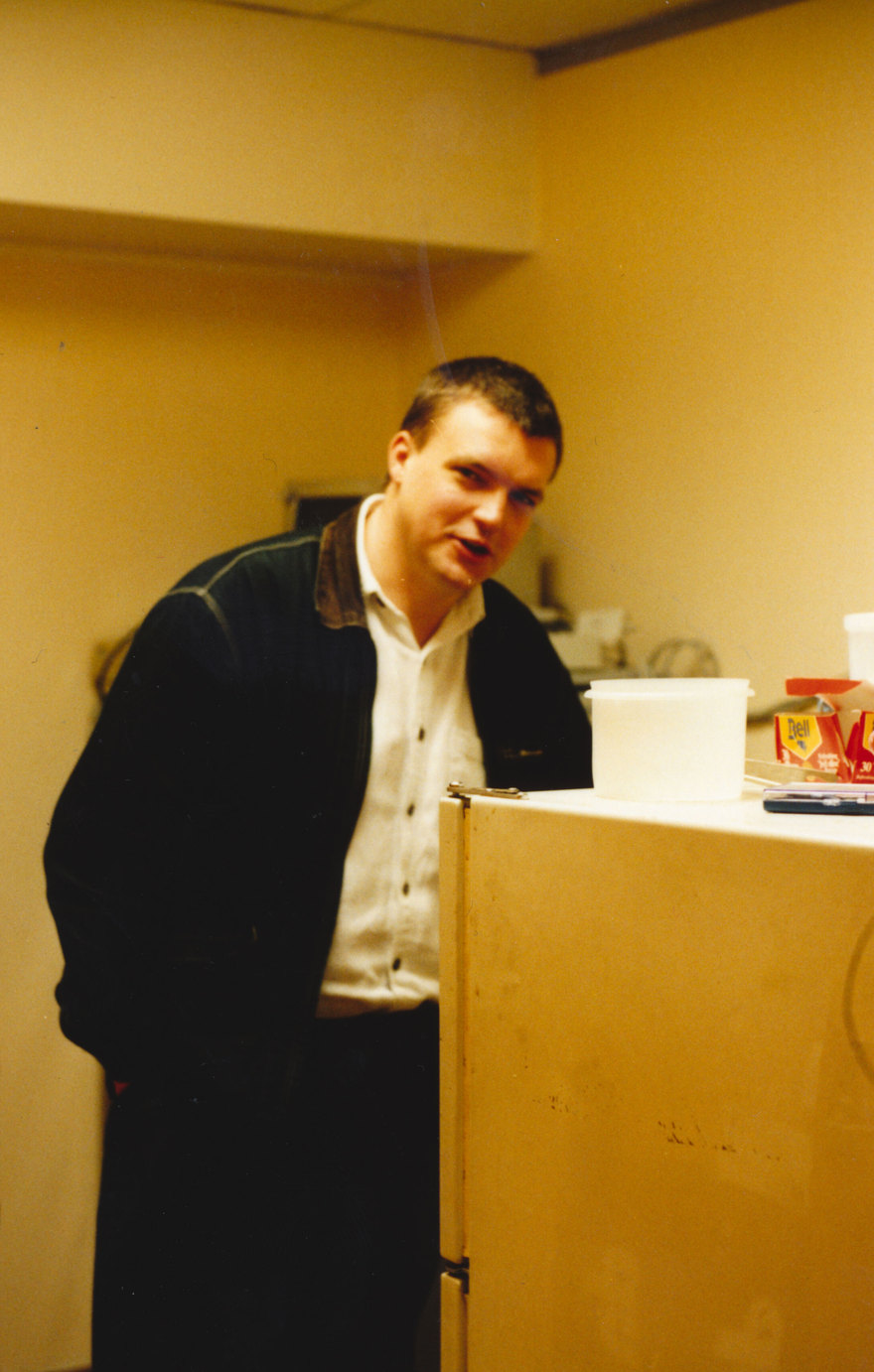
Patrick Fife was Rip It Up advertising salesman in 1997
After completing my 1977 teacher-training year, I had failed to get a teaching job, so I went fulltime on Rip It Up. Gradually my working fulltime and reporting to a part-time editor, didn’t work and I took over the editor role in May 1979 and Alastair focused on his law degree.
I was a bit green on sub-editing and we had so many experienced writers, that I left most copy untouched. An envelope from Jeremy Templer suggested this sub-editing policy would be good for my wellbeing. It read, "If you edit this your toes will drop off and some day you will marry a large woman with a moustache."
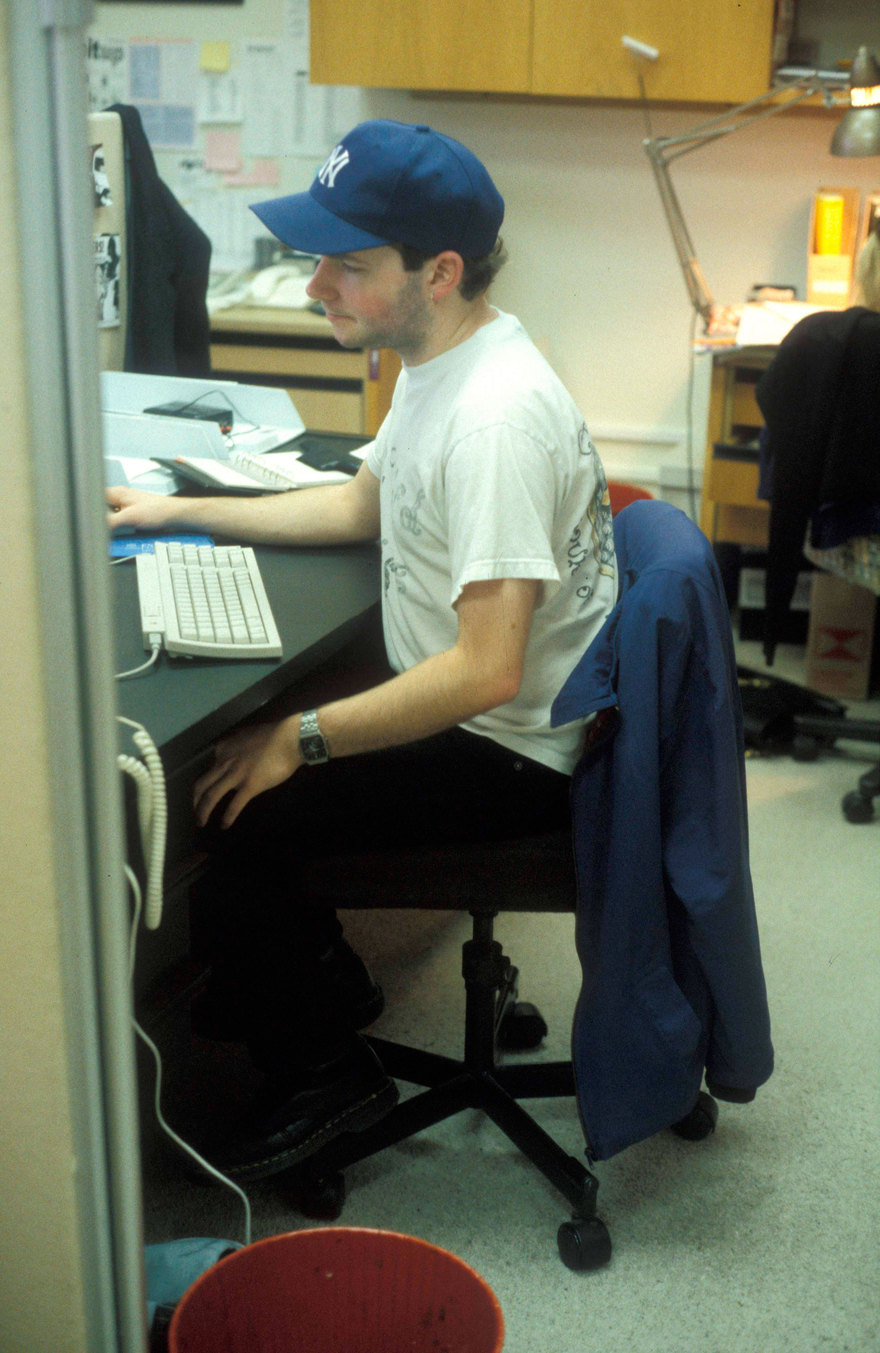
Writer John Russell in the BNZ Tower offices in 1994
Being new to the job when Elvis Presley died in August 1977 we didn’t know what to do and Rip It Up was possibly the only music magazine in the world that did not put him on the cover. We had Split Enz on the cover as they were touring in September.
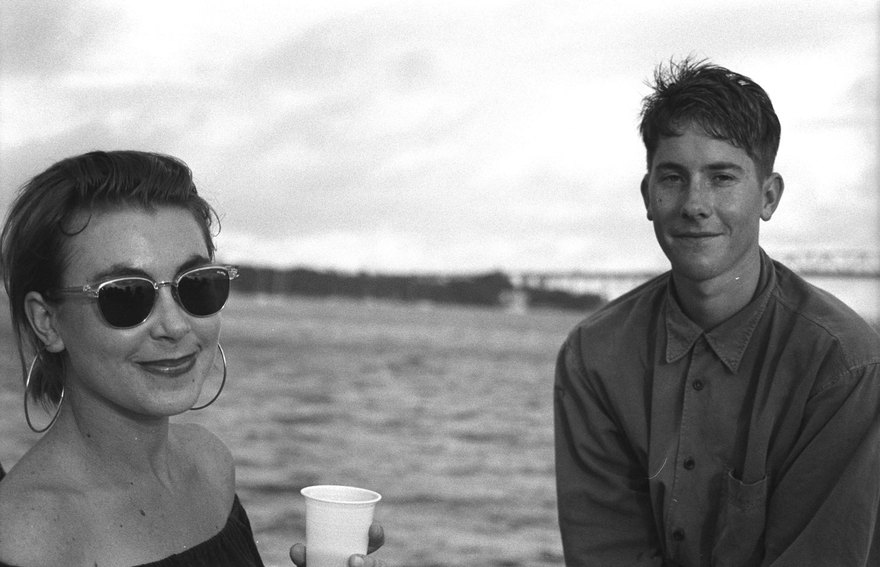
Receptionist Simmonde Norden and photographer Chris Mauger
So Rip It Up started with a nucleus of young of guys, many of whom came from the mean streets of St Heliers and studied at Auckland University. The only time such a narrow socio-demographic would again dominate New Zealand music journalism would be in the mid-1990s when three Rip It Up staff members were graduates of Tokoroa Primary School – John Russell, Bronwyn Trudgeon and Hans Hoeflich.
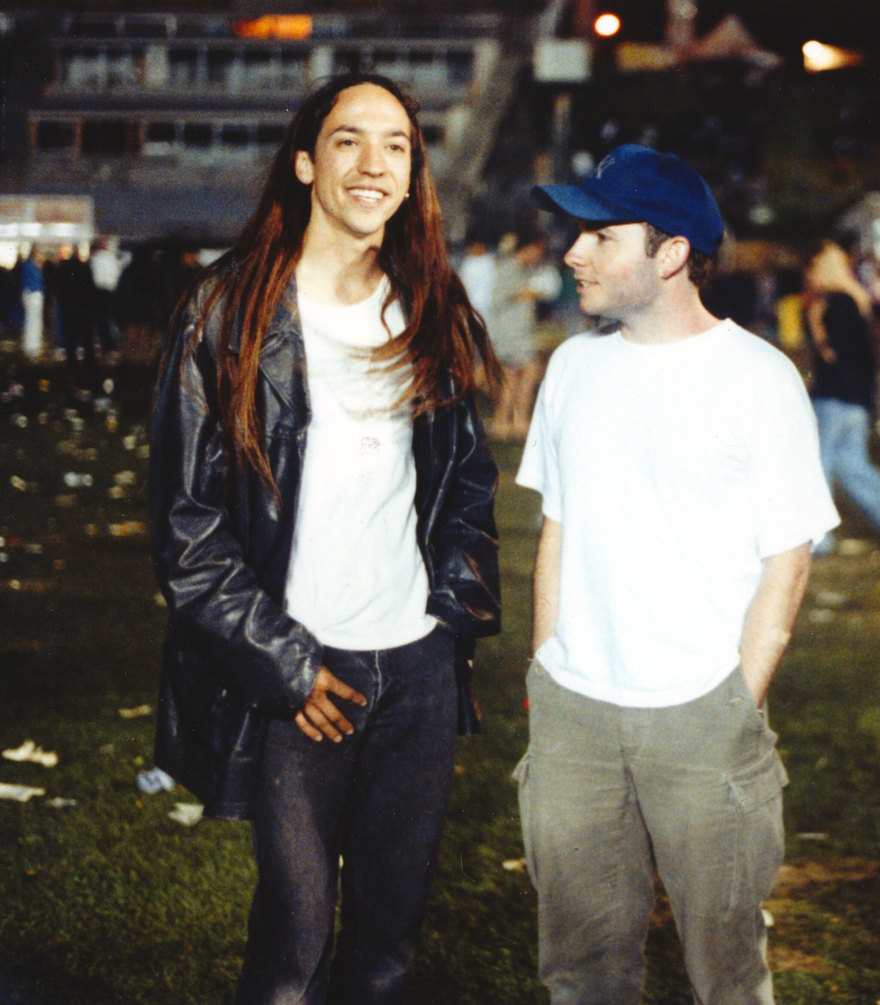
Jon Toogood and John Russell at Big Day Out, 1995
Back to the 70s. When Joy Division released Unknown Pleasures in 1979, I had my first mid-life crisis. I could not appreciate their doom and gloom and I rushed to hire a younger writer to keep the magazine connected to the youth market. The first writer to be hired was Mark Phillips as trend-o-meter No.1 to keep Rip It Up in touch with the local live scene, the indie singles boom, the very influential British scene and the emerging club culture.
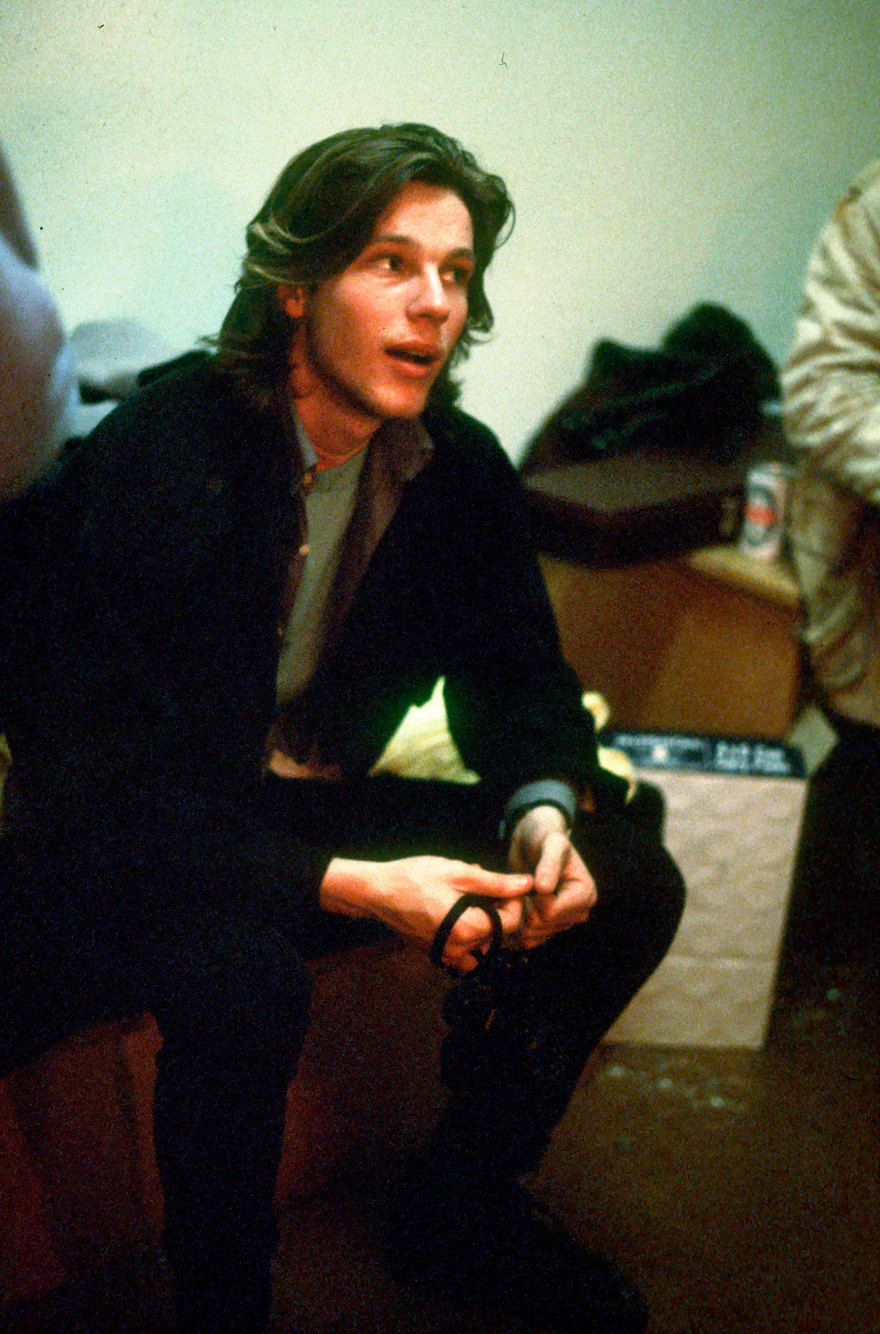
Photographer Kerry Brown
A series of writers would take Rip It Up through the 1980s to the grunge 1990s as imported fads flowed in thick and fast – ska, new romantic, USA indie, big-hair bands, hip-hop, Brit-pop, Southern California punk, the Manchester sound etc. Russell Brown covered Flying Nun, alternative, and the beer drinking exploits of the Dance Exponents.
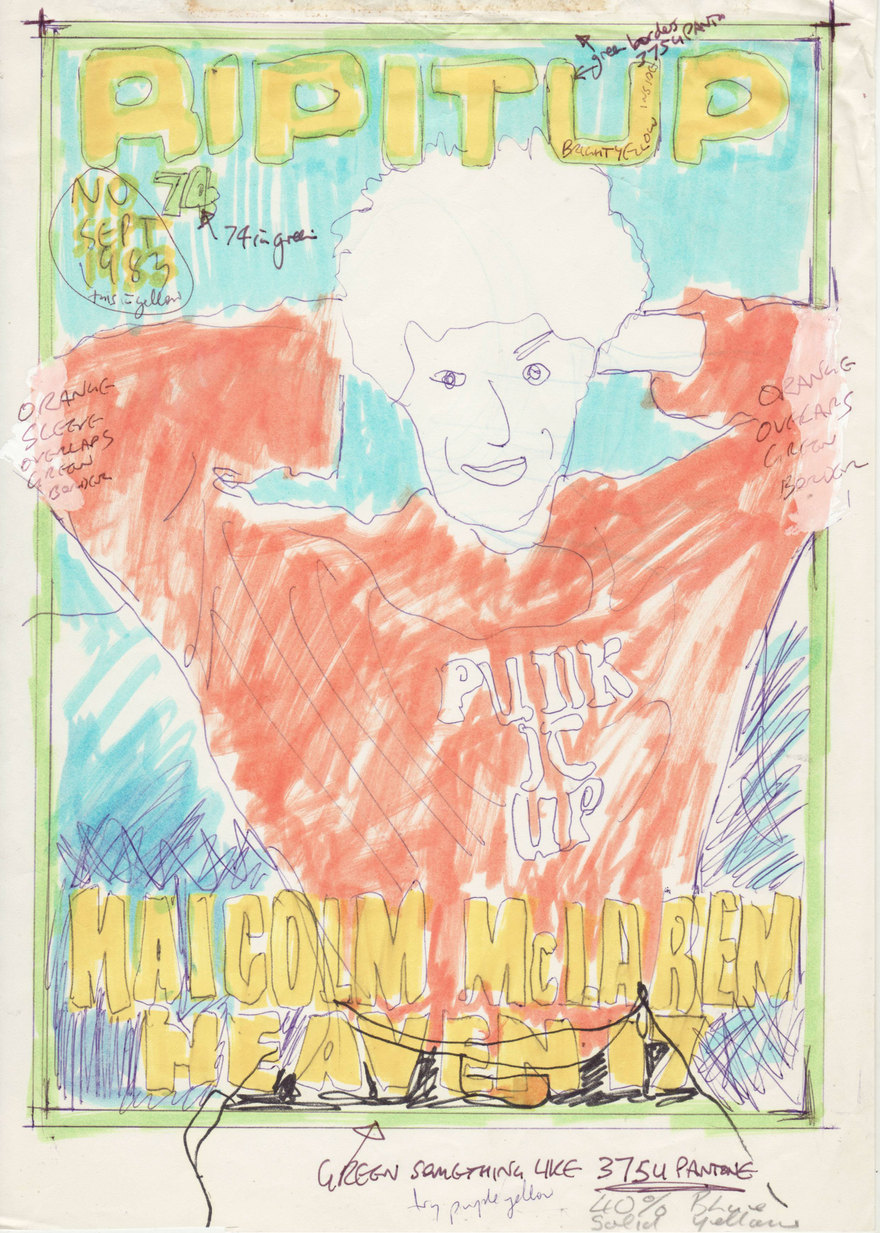
The Malcolm McLaren cover colour guide
Chris Bourke added a more serious tone, as Rip It Up embraced the new alternative represented by Herbs and Dalvanius. At the time Rip It Up was also seeking to differentiate itself from our teen magazine Shake!, to achieve a majority 20+ readership and retain alcohol advertising. Writers Babs Baker and Angela Jonasson were the stars of Shake! magazine and they interviewed Duran Duran, Guns N’ Roses, The Mockers, etc.
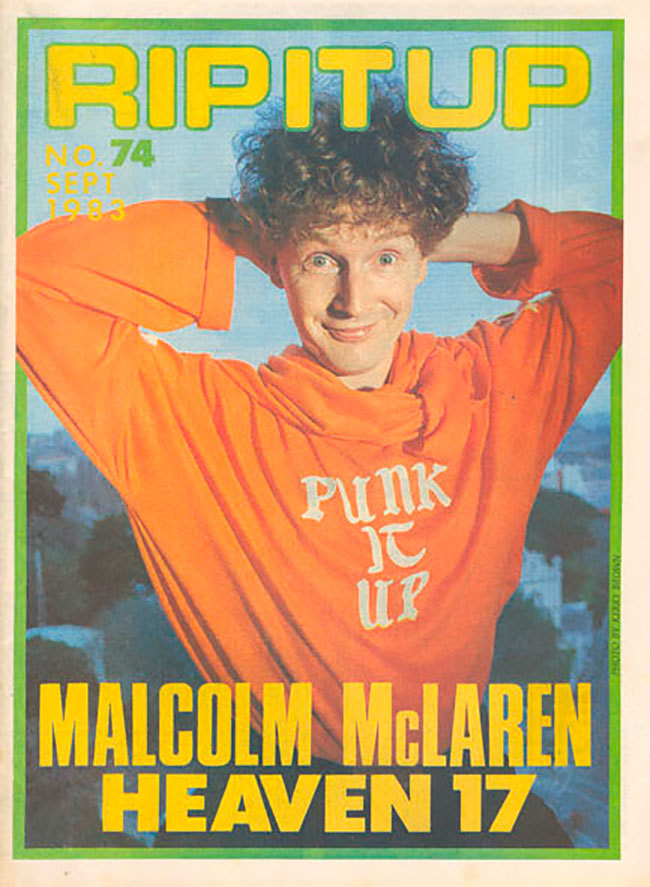
The finished cover, photograph by Kerry Brown, September 1983
Writer Chad Taylor was on board from 1988, after many years as our part-time graphics helper and writer while he was at Elam Art School. Former More magazine writer Donna Yuzwalk thought Rip It Up smelled like men’s smelly socks and she was hired to enliven our early 90s coverage of the local scene as we went grunge-crazy.
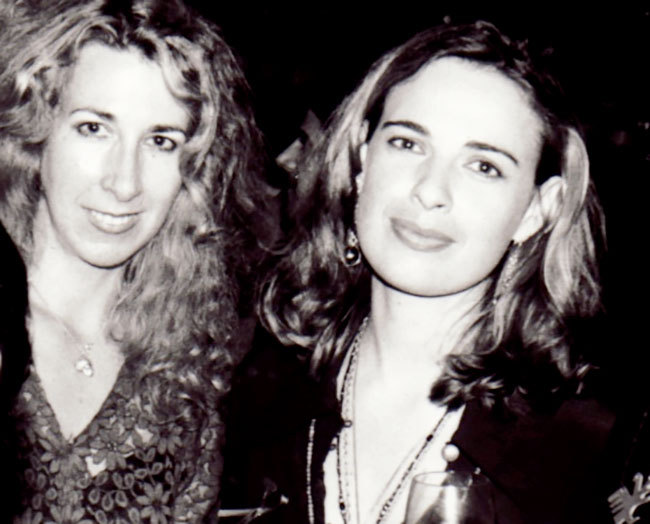
Writer Donna Yuzwalk and Jan Hellriegel
A succession of designers would put together Rip It Up and most of its record company advertisements, including Stefan Morris, Ian Dalziel, John Pitcairn, Steve Simpson, Jonathan King and Ryan Henderson.
I am very proud of the issues we produced in the grunge era, both before and after the change of ownership in February 1994 that would lead to Rip It Up gaining a price on its masthead. The 1994 to 1998 team with John Russell as the staff writer produced some of the best issues of Rip It Up, fuelled by a vibrant local and international music scene with the annual Big Day Out festival as the focal point. The designers of that era, Ryan Henderson and Struan Ashby, were young masters of the new computer-based graphic design.
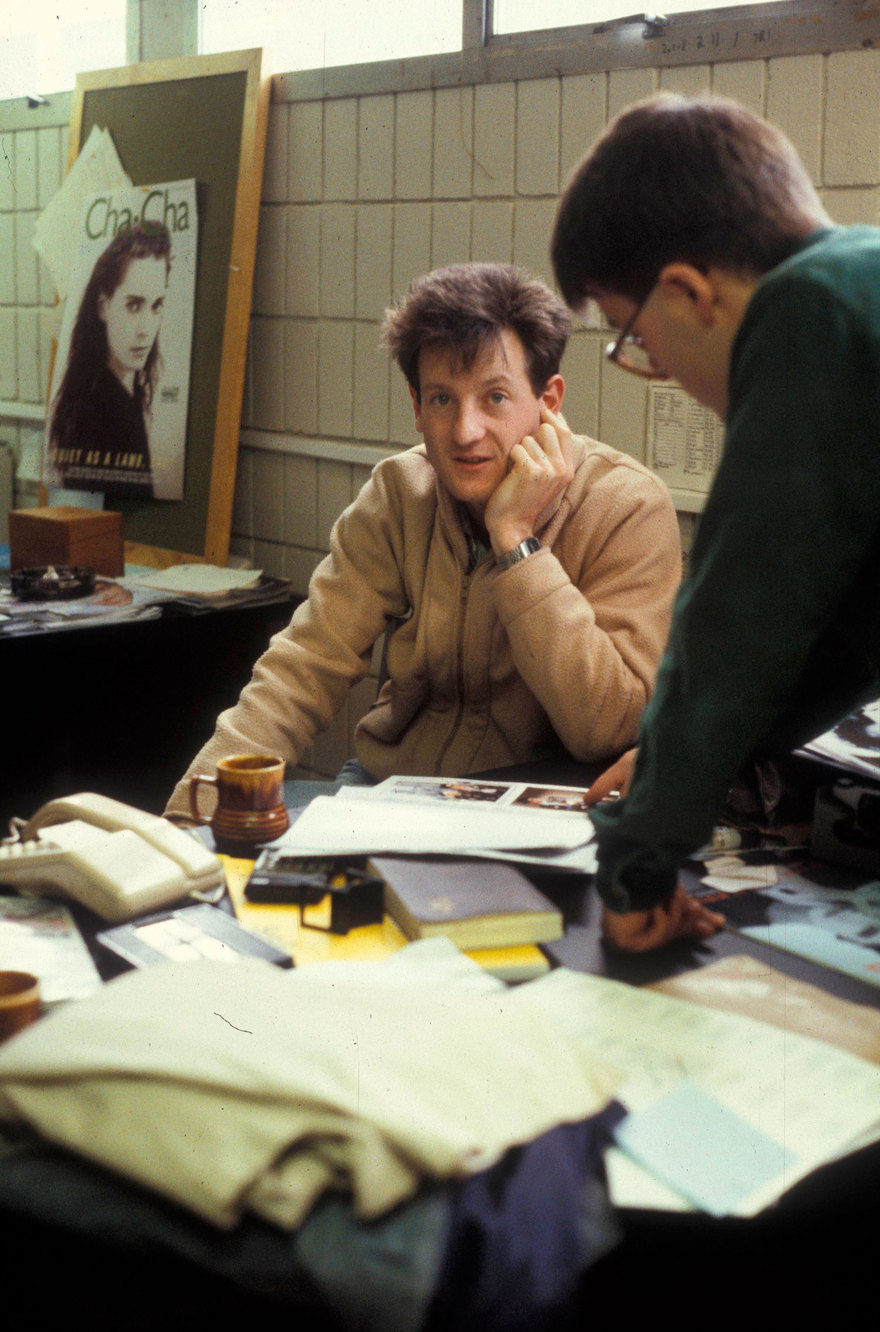
Designer John Pitcairn and Editor Chris Bourke, 1987
I was editing Rip It Up in 1994 when the new publisher, Barry Colman of the Liberty Group, decided to put a $2 cover price on Rip It Up. The 200th issue sold well with TV adverts, a free CD and The Mutton Birds on the cover (approx. 20,000 sales). Also selling well that year was the issue that followed the death of Kurt Cobain (approx. 17,000).
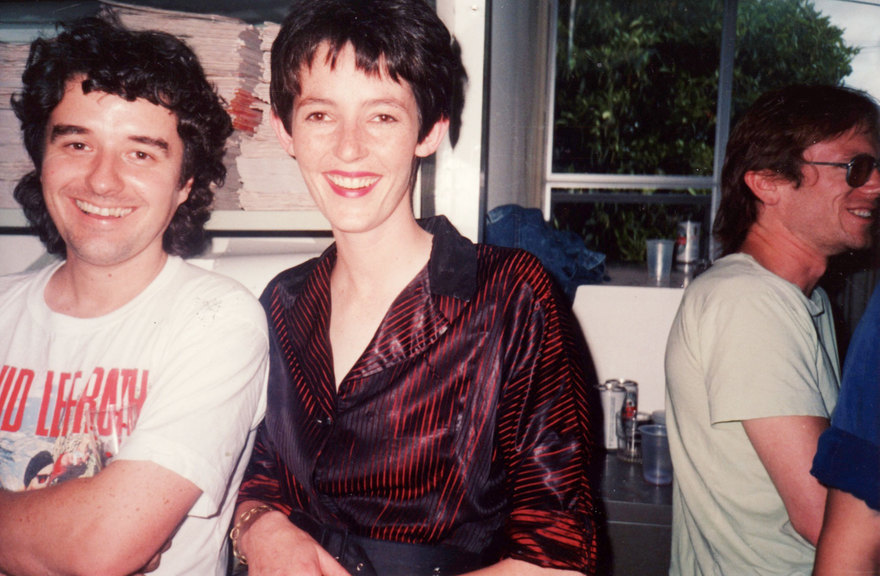
Murray Cammick, writer Angela Jonasson and design assistant Yoh
Although the 1990s gave Rip It Up excellent cover stories, including Pearl Jam, Courtney Love, Offspring, Marilyn Manson, Foo Fighters, Supergroove, Blur, Oasis, Prodigy, Rage Against The Machine, Shihad, Garbage, Garageland etc, the Rip It Up newsstand sales declined by 1996 to give the magazine an ABC circulation audit of 8,964. I ended my run as editor in 1998 when the Liberty Group closed Rip It Up.
Rip It Up continued with new publishers and numerous editors over the following few years, but gained stability when David Rose of Satellite Media took over publishing in 2002. Issues came out six times a year, beautifully printed on good quality paper that ad agency advertisers loved, but I always viewed this format as a “coffee table” magazine and I thought Rip It Up would be more relevant as a fortnightly publication, not every two months. At the time, David Rose spoke of returning Rip It Up to a monthly format.
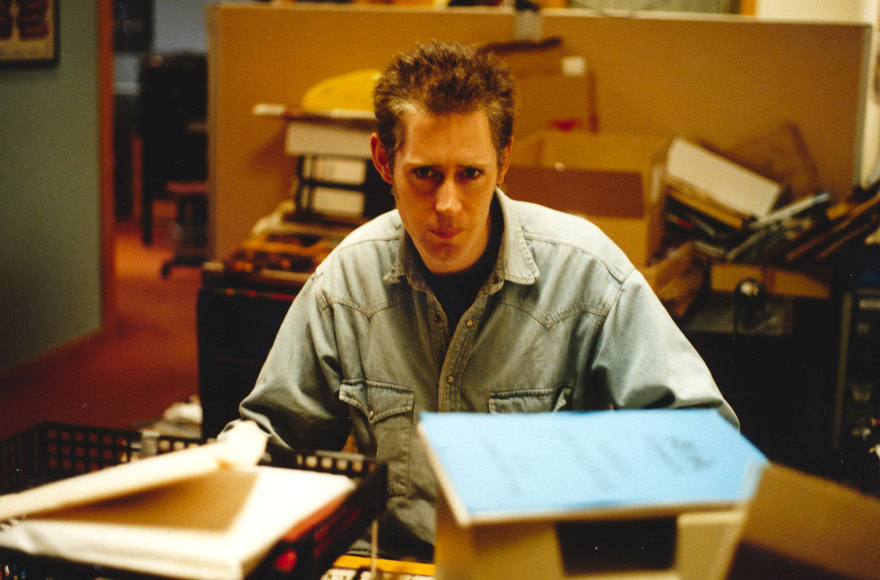
Troy Ferguson at reception, 1997
In August 2013 Satellite Media sold Rip It Up to Hark Entertainment and Grant Hislop announced that Rip It Up would return to a free format. I was pleased to hear the news. When I co-founded the magazine in June 1977 with Alastair Dougal, the free format was already familiar to music readers, as we followed Hot Licks.
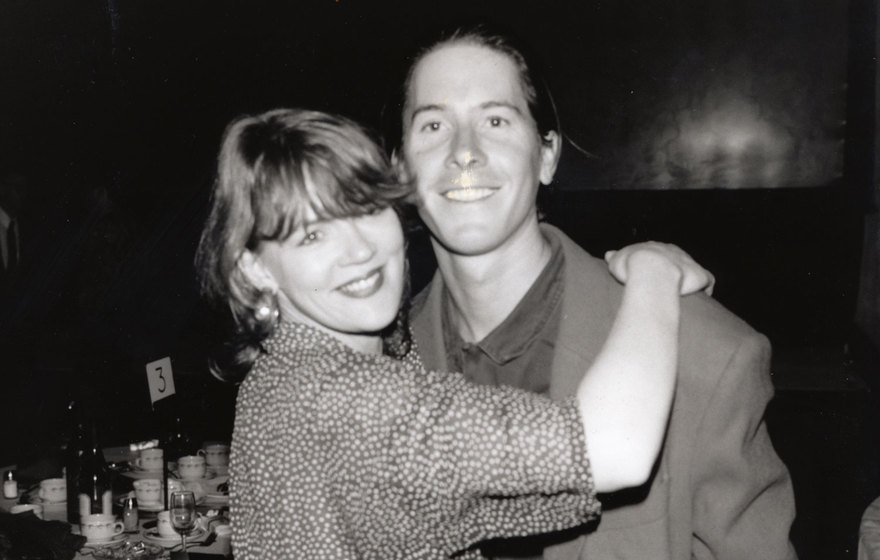
Office Manager Sheryl Morris and photographer Chris Mauger
The rationalisation behind not charging a cover price was that a serious music magazine primarily targets the 18-plus young adult, tertiary student market, readers who are often broke and would prefer to spend their limited income on a beer or a gig, rather than a magazine.
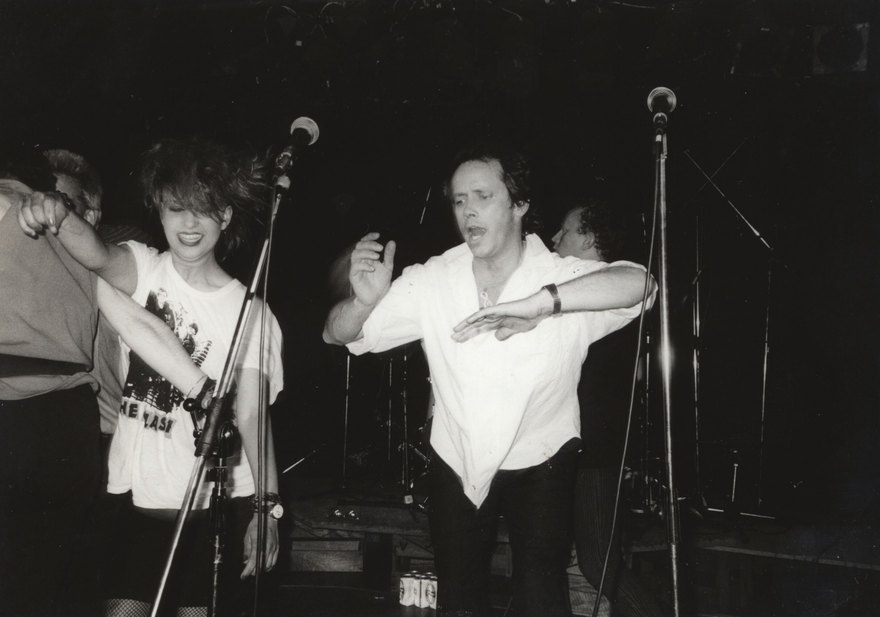
Ray Columbus shakes She's a Mod at the Rip It Up 100th issue party, November 1985 at The Six Month Club.
The years that Satellite Media published Rip It Up saw a series of great editors, including Scott Kara who moved on to the NZ Herald, Phil Bell (DJ Sir-Vere) who moved to Mai FM, and the final Satellite Media editor, Leonie Hayden. Phil originally joined the company to edit their 2005 relaunch of the hip-hop magazine Back2Basics. As a secondary school student, Phil had climbed the stairs to Rip It Up’s Darby Street office to buy back issues of the magazine.
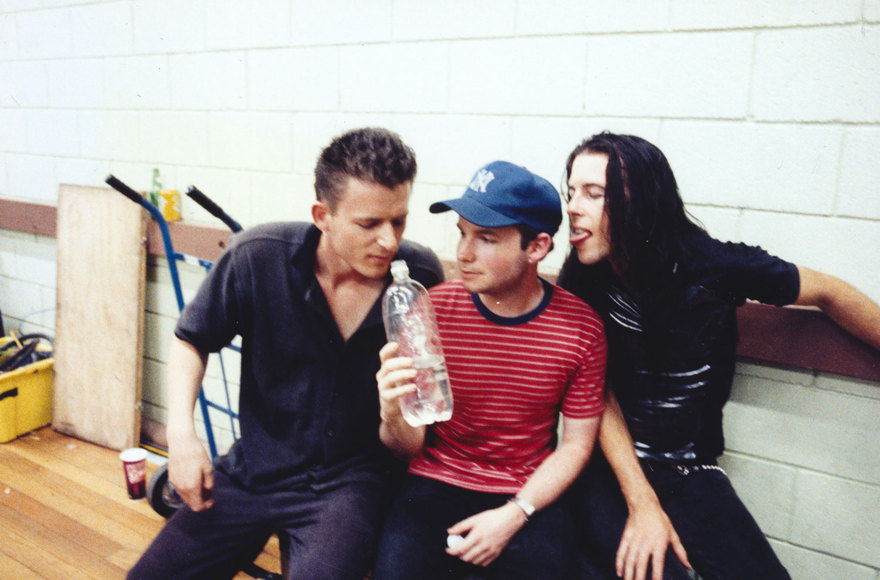
Supergroove's manager Stuart Broughton, writer John Russell and Dead Flowers' Damon Newton
I don’t agree when people say the heyday of Rip It Up was around 1980. The magazine was only getting started in 1980. I think the best ever issue of Rip It Up was this century, the 30th Anniversary issue in 2007 with Karl Puschmann as editor. The runner-up best ever issue is the 35th Anniversary issue June/July 2012 with Leonie Hayden as editor.
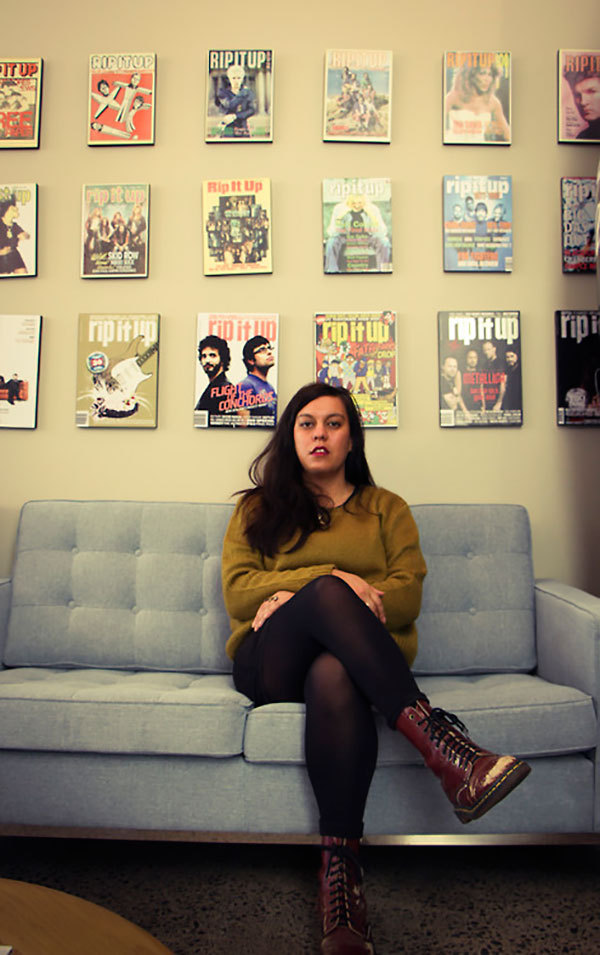
Editor Leonie Hayden - Photo by Lee Rose Gilmour
And best ever Rip It Up cover also goes to the June/July 2009 issue, in the Satellite era with Phil Bell as editor, when Otis Frizzell illustrated the Fat Freddy’s Drop cover.
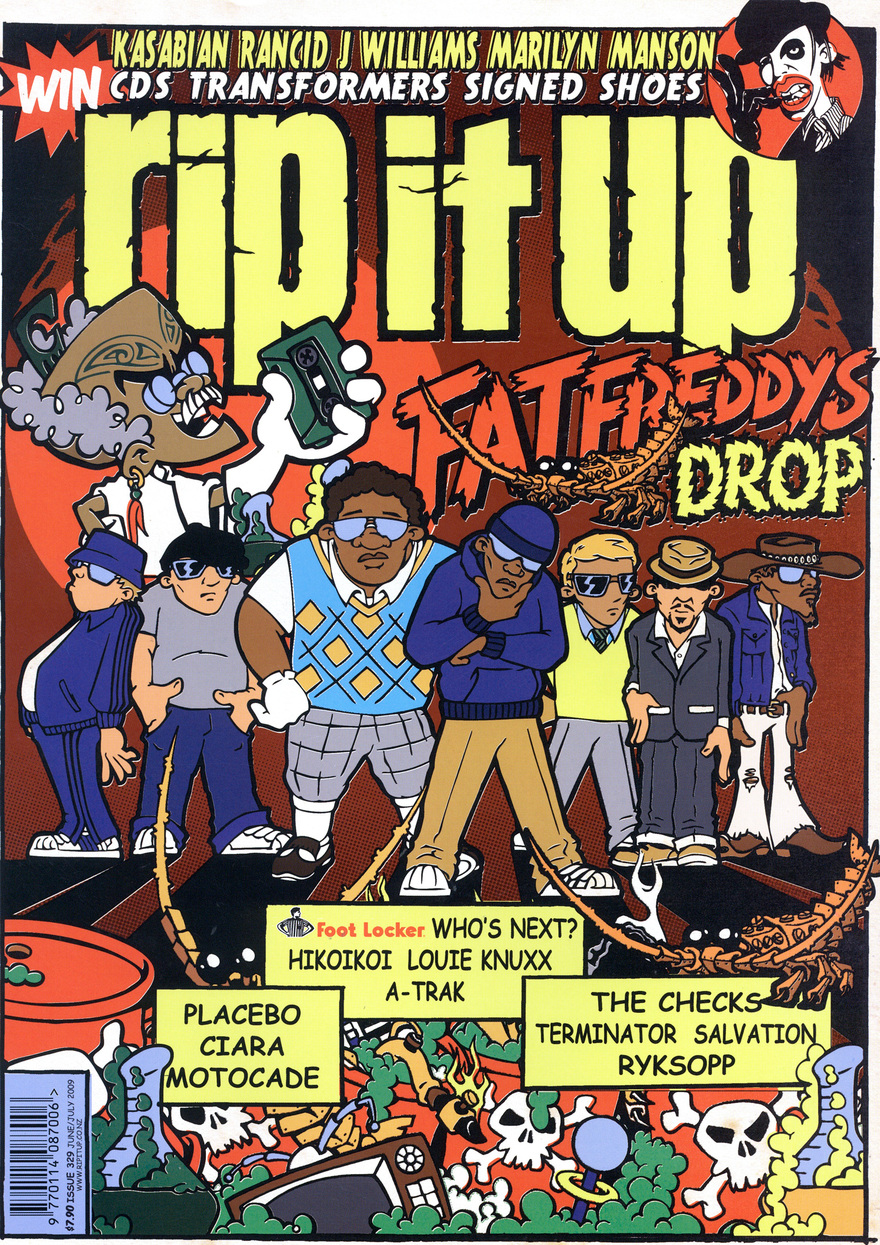
Rip It Up June/July 2009
–
Read more: Rip It Up 101 - the New Zealand covers
Murray Cammick interviewed by Karyn Hay, Radio With Pictures, 1985
All photos by Murray Cammick unless otherwise noted.